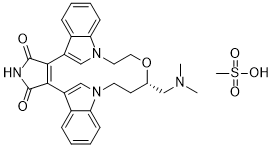This product is for research use only, not for human use. We do not sell to patients.

| Size | Price |
|---|---|
| 250mg | Get quote |
| 500mg | Get quote |
| 1g | Get quote |
Cat #: V3124 CAS #: 192050-59-2 Purity ≥ 98%
Description: Ruboxistaurin mesylate (LY333531 mesylate), the mesylate salt of Ruboxistaurin, is a potent and specific inhibitor of PKCβ (protein kinase C) with antidiabetic activity. It acts by competitively and reversibly inhibiting PKCβ1 and PKCβ2 with IC50 values of 4.7 and 5.9 nM respectively. It has the usefulness to treat diabetic nephropathy and diabetic macular edem. LY333531 strikingly decreases the chance of HUVEC survival and the effect of LY333531 on apoptotic cell death in HUVEC significantly increases compared with the AGEs group. Blockade of PKC-beta up-regulates the expression of Bax and Bad proteins and down-regulates the expression of Bcl-2 protein. Moreover, LY333531 reduces the ratio of Bcl-2/Bax.
Publications Citing InvivoChem Products
Product Promise

- Physicochemical and Storage Information
- Protocol
- Related Biological Data
- Stock Solution Preparation
- Quality Control Documentation
| Molecular Weight (MW) | 564.66 |
|---|---|
| Molecular Formula | C29H32N4O6S |
| CAS No. | 192050-59-2 |
| Storage | -20℃ for 3 years in powder form |
| -80℃ for 2 years in solvent | |
| Solubility In Vitro | DMSO: N/A |
| Water: N/A | |
| Ethanol: N/A | |
| Synonyms | LY-333531 Mesylate; LY333531;Ruboxistaurin mesylate; LY-333531; LY 333531; LY-333531 Mesylate |
| Protocol | In Vitro | In vitro activity: LY333531 strikingly decreases the chance of HUVEC survival and the effect of LY333531 on apoptotic cell death in HUVEC significantly increases compared with the AGEs group. Blockade of PKC-beta up-regulates the expression of Bax and Bad proteins and down-regulates the expression of Bcl-2 protein. Moreover, LY333531 reduces the ratio of Bcl-2/Bax. LY333531 can further prompt AGEs-induced endothelial cells apoptosis. The increased expression of Bax, Bad and decreased expression of Bcl-2 and Bcl-2/Bax ratio are associated with the apoptotic process. Kinase Assay: Ruboxistaurin hydrochloride is a selective and ATP-competitive PKCβ inhibitor, with IC50s of 4.7 and 5.9 nM for PKCβI and PKCβII, shows less potent inhibition on PKCη (IC50, 52 nM), PKCα (IC50, 360 nM), PKCγ (IC50, 300 nM), PKCδ (IC50, 250 nM), and has no effect on PKCζ (IC50, >100 μM). Cell Assay: HUVECs are seeded into 96-well plates in low glucose DMEM with 10% FBS for 12 h. Afterwards, HUVECs are starved for 12 h and incubated with BSA (200 μg/ml), AGEs (200 μg/ml) and LY333531 (200 nM)+AGEs (200 μg/ml) for 48 h. Then, the medium is replaced with 0.5 mg/ml MTT and at 37 ◦C in a 95% air/5% CO2 incubator for 4 h. Finally, the medium containing MTT is aspirated and replaced by dimethyl sulphoxide (DMSO). OD is measured with a Microplate spectrophotometer. AGEs:advanced glycation end products. |
|---|---|---|
| In Vivo | LY333531 treatment (for a duration of 4 weeks) prevents excessive PKCb2 activation and attenuates cardiac diastolic dysfunction in rats with streptozotocin-induced diabetes. LY333531 suppresses the decreased expression of myocardial NO, Cav-3, phosphorylated (p)-Akt, and p-eNOS and also mitigates the augmentation of O2-, nitrotyrosine, Cav-1, and iNOS expression. | |
| Animal model | Rats with streptozotocin-induced diabetes |
| Solvent volume to be added | Mass (the weight of a compound) | |||
|---|---|---|---|---|
| Mother liquor concentration | 1mg | 5mg | 10mg | 20mg |
| 1mM | 1.7710 mL | 8.8549 mL | 17.7098 mL | 35.4195 mL |
| 5mM | 0.3542 mL | 1.7710 mL | 3.5420 mL | 7.0839 mL |
| 10mM | 0.1771 mL | 0.8855 mL | 1.7710 mL | 3.5420 mL |
| 20mM | 0.0885 mL | 0.4427 mL | 0.8855 mL | 1.7710 mL |
This equation is commonly abbreviated as: C1 V1 = C2 V2
- (1) Please be sure that the solution is clear before the addition of next solvent. Dissolution methods like vortex, ultrasound or warming and heat may be used to aid dissolving.
- (2) Be sure to add the solvent(s) in order.




































